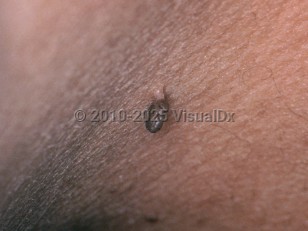Acrochordon in Infant/Neonate
See also in: AnogenitalAlerts and Notices
Important News & Links
Synopsis

Acrochordons, also known as skin tags or fibroepithelial polyps, are common benign cutaneous growths. They present as small, skin-colored or brown, soft papules and are most commonly found in areas of frequent friction such as the eyelids, neck, axillae, and inguinal area. Acrochordons are usually asymptomatic but can become irritated by clothing or jewelry. Occasionally, skin tags twist upon their own stalk, which leads to strangulation of their blood supply and spontaneous necrosis of the skin tag. Acrochordons are associated with increasing age, pregnancy, diabetes, and obesity. Men and women are affected equally, and there is no difference in prevalence among different ethnicities and races.
Acrochordons can also be a feature of the autosomal-dominantly inherited Birt-Hogg-Dubé syndrome. They can also be seen in large numbers in tuberous sclerosis. They are increased in number in acromegaly and are sometimes associated with acanthosis nigricans.
Acrochordons can also be a feature of the autosomal-dominantly inherited Birt-Hogg-Dubé syndrome. They can also be seen in large numbers in tuberous sclerosis. They are increased in number in acromegaly and are sometimes associated with acanthosis nigricans.
Codes
ICD10CM:
L91.8 – Other hypertrophic disorders of the skin
SNOMEDCT:
201091002 – Skin tag
L91.8 – Other hypertrophic disorders of the skin
SNOMEDCT:
201091002 – Skin tag
Look For
Subscription Required
Diagnostic Pearls
Subscription Required
Differential Diagnosis & Pitfalls

To perform a comparison, select diagnoses from the classic differential
Subscription Required
Best Tests
Subscription Required
Management Pearls
Subscription Required
Therapy
Subscription Required
References
Subscription Required
Last Reviewed:05/10/2023
Last Updated:05/23/2023
Last Updated:05/23/2023
 Patient Information for Acrochordon in Infant/Neonate
Patient Information for Acrochordon in Infant/Neonate
Premium Feature
VisualDx Patient Handouts
Available in the Elite package
- Improve treatment compliance
- Reduce after-hours questions
- Increase patient engagement and satisfaction
- Written in clear, easy-to-understand language. No confusing jargon.
- Available in English and Spanish
- Print out or email directly to your patient
Upgrade Today

Acrochordon in Infant/Neonate
See also in: Anogenital
